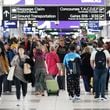If all goes according to plan, three NFL stadiums will open in a four-year span — the San Francisco 49ers’ new home in 2014, the Minnesota Vikings’ in 2016 and the Falcons’ in 2017. Combined cost: more than $3 billion.
The stadiums will be strikingly different in many ways. For starters, the 49ers’ will be open-air, the Vikings’ will feature a fixed roof and the Falcons’ will sport a retractable roof.
But, collectively, the designs for this next generation of NFL venues demonstrate how teams will attempt to use technology to redefine the fan experience and lure folks from their big-screen high-definition TVs at home — a major concern of the NFL and other sports leagues.
The stadiums’ plans, all by different architects, reflect a number of trends — maximizing seats in the lower bowls and along the sidelines, creating field-level club areas, reducing end-zone seating, showcasing views of the surroundings and, of course, providing high-speed Wi-Fi for every fan in the stands. The seating capacities will be similar at each of the stadiums, ranging from 65,000 to 70,000, and expandable for mega-events, such as the Super Bowl.
The stadiums are in varying stages of development, but after approval last week of the Falcons’ conceptual plans, at least the general design direction is known for all three projects. Here’s a look at each of them, in order of scheduled opening:
49ERS’ STADIUM
Overview: Recently named Levi's Stadium and already selected as the site of Super Bowl L in February 2016, this open-air facility will have a white painted steel structure, a natural grass field, views of Silicon Valley and a stack of suites on one side.
Location: Santa Clara, Calif., about 40 miles from San Francisco.
Status: More than 50 percent completed and on schedule to open in 2014.
Fan experience: The 49ers vow this will be the most technologically advanced stadium anywhere. They say it will be cash-free and ticket-less for fans with smartphones and pledge that all 68,500 fans will be able to connect to the Wi-Fi network simultaneously. They promise apps that can be used to order food, watch instant replays and check bathroom lines from seats. (In-seat tablet holders are planned.) Video boards will total 13,000 square feet. Concourses will average 63 feet in width, compared with 19 feet at Candlestick Park, the 49ers' current stadium.
Something extra: Seats in two sections on opposite sides of the 50-yard line, which have sold out despite a one-time license fee of $80,000, plus $3,750 per season, include access to private field-level club spaces and the right to roam the area behind the players during games.
Cost: The stadium's price recently rose to $1.3 billion as the 49ers added $100 million in technology upgrades.
Funding: $114 million public contribution by Santa Clara, $200 million in NFL funding and the rest largely from $850 million borrowed by the Santa Clara Stadium Authority that is to be repaid with revenue from personal seat licenses ($400 million worth already sold at prices ranging from $2,000 to $80,000 per seat), naming rights (the deal with Levi Strauss is worth $220 million over 20 years) and 49ers rent.
VIKINGS’ STADIUM
Overview: The enclosed stadium will be topped by a dramatic, sharply sloped roof, about 60 percent of which will be made of a clear plastic-like material to let in natural light. Giant glass doors will open to the Minneapolis skyline.
Location: On the site of the Metrodome, the Vikings' 31-year-old stadium.
Status: Work is scheduled to begin on the edge of the site in October, intensify after the Metrodome is demolished early next year and be completed by July 2016. The Vikings will play the 2014 and '15 seasons at the University of Minnesota.
Fan experience: The clear roof will aim to make fans feel as if they're watching a game outdoors — without being exposed to the Minnesota winter. (A retractable roof was deemed too expensive for the limited use it would get.) The stadium will have two 50-by-120-foot video boards in the end zones and 1,200 HDTVs in the concourses. The seats will come within 44 feet of the sidelines, making them among the closest to the action in the NFL.
Something extra: Plans include special lounges for following fantasy football results, designed for fans accustomed to tracking multiple games at home.
Cost: The stadium budget is $975 million.
Funding: $498 million in public contributions from the state and city, $200 million in NFL funding and the rest from the Vikings, who can offset their portion through the sale of naming rights and seat licenses.
FALCONS’ STADIUM
Overview: A futuristic roof will open, like the aperture of a camera, in eight pieces over the center of the 70,000-seat stadium. A soaring wall of glass behind one end zone will showcase the downtown skyline. A translucent skin will envelope the exterior of the angular building.
Location: The preferred site, the only one shown in the conceptual drawings, is immediately south of the Georgia Dome. It requires buying two churches by Aug. 1; negotiations continue. An alternate site is a half mile north of the Dome.
Status: Detailed schematic drawings are to be done by October and a final design by April. Construction is scheduled to begin by mid-2014 and to be completed by March 2017.
Fan experience: The plan is to remove the video boards from their customary perches in the end zones and integrate them into the ring below the roof opening in the center of the stadium. As the architects envision it, the 360-degree series of screens will allow fans to look across the field and see game video relative to their seat location, providing a customized camera angle that TV cannot offer. The architects enlarged the roof opening from their original idea in an attempt to create the feel of an outdoor stadium that closes, rather than an indoor stadium that opens, but they believe the roof's fixed portion remains sizable enough to keep the decibel level high.
Something extra: No word on whether the proposed vibrating seats — seats that shake with hard hits on the field — will make the final blueprint.
Cost: Preliminary estimates have ranged from about $950 million to $1 billion.
Funding: $200 million toward construction from bonds backed by Atlanta hotel-motel taxes (plus projected hundreds of millions more from those taxes over 30 years toward interest, maintenance and operating costs), $200 million from NFL funding and the rest from the Falcons, personal seat licenses (prices haven't been announced) and probably naming rights.






